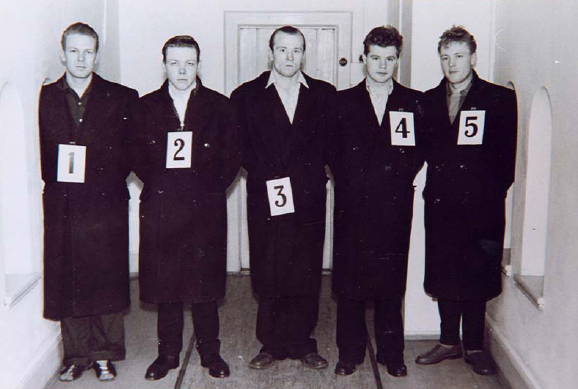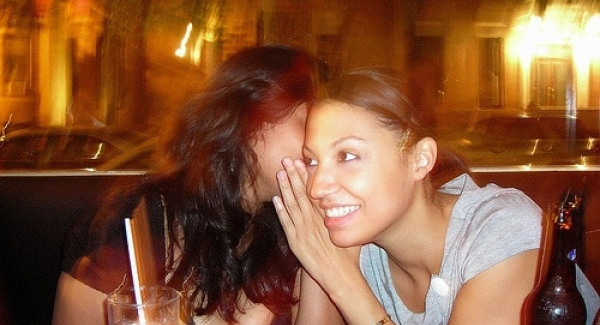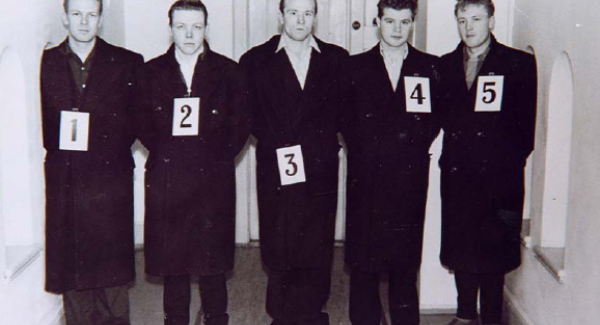
Would you be able to pick out the right person from a lineup? We discuss the role of various factors that can influence the decision-making process of eyewitnesses during the lineup procedures.
In 1985, Ronald Cotton was sentenced to life plus 54 years, based largely on a lineup identification. Tragically, DNA analyses performed in 1994 showed that Cotton was innocent. Although eyewitness identifications often provide important leads in police investigations, they can entail the risk of a wrongful conviction and miscarriage of justice. Would you be able to pick out the right person from a lineup? In this article we will take a closer look at different variables that can influence a witness’ decision-making during the identification procedure. Knowledge about these can help to increase witnesses' awareness of such influences that would otherwise remain unnoticed. This can ultimately help decision-makers to use more diagnostic information in their evaluations of eyewitness identification decisions.
Every day we are confronted with a multitude of faces and have to decide whether or not we are familiar with them. Mostly, our assessments are correct, as humans are actually experts in recognizing familiar faces. However, recognizing unfamiliar faces or those that we have encountered for only a short period of time is much more difficult (Johnston & Edmonds, 2009). For example, the use of pictures on credit cards for verifying the identity of the customer has proven to be far less beneficial than originally believed. In an experiment, researchers varied the similarity between a credit card picture and a mock customer (Kemp, Towell, & Pike, 1997). The mismatch between the picture and the customer was recognized in only 1/3 (high similarity) and 2/3 (low similarity) of the cases. Credit card fraud is but one offence in which face recognition plays an important role. Indeed, police investigations following muggings, robberies, rape and other serious offences frequently involve procedures in which eyewitnesses and victims are asked to identify the perpetrators. Yet, these identifications are often problematic.
In July 1984, a man broke into two apartments and sexually assaulted two women (see Thompson-Cannino, Cotton, & Torneo, 2010, and http://www.innocenceproject.org/Content/Ronald_Cotton.php, for a detailed description of the case). Ronald Cotton soon became a suspect and one of the victims, Jennifer Thompson, identified him from a photo lineup and subsequently from a live lineup. Further evidence of the prosecution involved a flashlight found in Cotton’s home that resembled the one used by the assailant, and rubber from Cotton’s tennis shoe that was consistent with rubber found at one of the crime scenes. Cotton was convicted and sentenced to life plus 54 years.
In 1994, the case drew the attention of the Innocence Project, a non-profit legal clinic that assists prisoners who could be proven innocent through DNA (deoxyribonucleic acid) testing. The mandated DNA tests revealed that the samples from one victim were too deteriorated to be conclusive, while those from the other victim showed no match with Cotton’s DNA. Consequently, Cotton was officially cleared of all charges and released from prison and officially pardoned.
Since 1992, the Innocence Project has been involved in the exoneration of more than 270 wrongly convicted persons. In 75% of these cases, incorrect eyewitness identifications were involved. Eyewitness identification evidence appears to be convincing to most people, including juries (Boyce, Lindsay, & Brimacombe, 2008; Wells, Penrod, & Memon, 2006). But it is obvious that things can go wrong, entailing high costs to both an innocent convict as well as society, as the true perpetrator is still free.
For a better understanding of the psychology of lineups, it is beneficial to take a look at the different possible lineup outcomes (see Figure 1). The suspect in the lineup can be identical with the perpetrator, or non-identical with the perpetrator (i.e., an innocent suspect). Moreover, when making a lineup decision, the witness has the option to choose someone from the lineup or to reject the lineup. According to signal-detection theory, this results in four different decision outcomes (Swets, Dawes, & Monahan, 2000). First, a true positive outcome occurs if the perpetrator is present in the lineup and the witness correctly identifies him/her. This is also called a hit. Second, a true negative outcome occurs if the perpetrator is not in the lineup and the witness rejects the lineup (correct rejection). Third, a false positive outcome occurs if the perpetrator is absent in the lineup, yet the witness identifies someone. This could be the wrongful identification of a foil (foil identification) or an innocent suspect (false alarm). Whereas the former is a known error, the latter describes a fatal error that can result in a wrongful conviction. Fourth, a false negative outcome occurs if the perpetrator is present in the lineup, but the witness rejects the lineup (incorrect rejection). Finally, the witness also has the option to refrain from making a decision (“don’t know” answer).
It is straightforward that witnesses’ identification decisions depend on cognitive factors, such as the memory strength regarding the perpetrator. A less intuitive cognitive factor may be the context in which the suspect is put in the recognition situation; that is, the manner in which the lineup is presented. Furthermore, social and meta-cognitive influences also play an important role (Brewer, Weber, & Semmler, 2007). Social influences include expectancy effects identified through Robert Rosenthal’s (1966, 2002) research on the effect of teachers' expectations on schools students. Meta-cognitive variables concern our intuitive theories of how memory works (e.g., “If I’m highly confident, I should be correct”; Winkielman & Schwarz, 2001). In the next section we discuss social, cognitive and meta-cognitive variables that can influence witnesses’ decision making during the identification procedure.
Social Influences
Lineup administration--double-blind testing
While a lineup is presented, neither the witness nor the lineup administrator should be aware of the suspect's identity--a technique known as double-blind. This helps to guard against the experimenter effect (Rosenthal, 1966, 2002), a well-known phenomenon in social psychology in which the experimenter's expectations drive participants' behaviors. Transferred to eyewitness identification, the experimenter effect can cause the lineup administrator to give the witness – consciously or unconsciously - verbal and nonverbal cues about the identity of the suspect (Quinlivan, Neuschatz, Cutler, Wells, McClung, & Harker, in press). This can lead to an increase in false alarms (Phillips, McAuliff, & Cutler, 1999) without witnesses being aware of the impact the administrator has on their decisions (Greathouse & Kovera, 2008).
However, a police officer blind to the identity of the suspect cannot exert such influence. For real-world cases, this means that the investigating police officer must not administer the lineup.
While eyewitnesses cannot be given the power to decide who will be administering the lineup, they will probably be aware of whether or not the lineup administrator knows the identity of the suspect. If this is the case, then the administrator’s behavior may have a substantial impact on the eyewitnesses’ behavior during the identification procedure. For instance, the administrator might indicate agreement with the eyewitnesses’ selection (consciously or unconsciously), which in turn might influence the confidence with which the eyewitnesses express their final decision.
Lineup instructions
When the lineup is presented to the witness, he or she receives an instruction. This instruction should include a warning that the perpetrator may or may not be amongst the persons shown (Steblay, 1997). This measure is to counteract expectancy effects, including the assumption that the real perpetrator is amongst the persons shown, or that the case is almost settled with only the confirming identification evidence of the witness missing. Although the usage of such an instruction can decrease hits, it also decreases false alarms and foil identifications (Brewer & Wells, 2006; Steblay, 1997).
Regardless of how--or whether--the lineup instruction is given, witnesses should always be aware of the fact that it is permissible to reject the lineup, or to say “I don’t know”. Witnesses should always keep in mind that only they have the knowledge about the sequence of events and the perpetrator’s appearance. Therefore, the decision to make a choice (or not) lies exclusively with the witness.
Feedback
When a witness has made his/her identification decision it may seem desirable to receive some sort of feedback regarding this decision. However, positive feedback (e.g., “Good, you identified the suspect”) has an impact on witnesses’ memory for details of the event. For example, participants who have received positive feedback evaluate their memories as clearer, report having had a better view of the perpetrator, and remember having paid more attention to him/her, compared to a no feedback condition (Wells & Bradfield, 1998; Douglass & Steblay, 2002). Furthermore, participants who received positive feedback are more confident about their identification decisions. Negative feedback (“Oh, the suspect was number xy”) has a reversed effect, but less pronounced and not for all of the named variables. Obviously, none of this is conducive to the police investigations.
Witnesses who have received feedback after their identification decisions are advised to display a good degree of suspicion towards their memories of the event. Furthermore, they should take into account that the feedback may have altered their memories. This would also be important to express in court when making a statement about the identification decision.
Cognitive Factors
Lineup presentation
The term lineup presentation refers to the context in which the suspect is shown. While a lineup presents the suspect among several foils, a "showup" only consists of one person. Consequently, a showup instantly reveals the identity of the suspect and offers less protection to innocent suspects. A meta-analysis (Steblay, Dysart, Fulero, & Lindsay, 2003) compared identification performance in lineups vs. showups. Looking at conditions in which the perpetrator was present in the array, the hit rates of these two procedures were about the same. However, eyewitnesses were more likely to accurately state that the perpetrator was not present (thus, resulting in a higher correct rejection rate) in showups than in lineups. Despite this, the showups also produced higher false identification rates when the perpetrator was absent.
Another finding discredits the use of showups. Suspects displayed in showups are mostly arrested, merely because they were close to the crime scenes and generally matched the descriptions provided by the witnesses, including the descriptions of the clothes worn. This can have detrimental consequences in cases in which an apprehended innocent suspect happens to wear the same or similar kind of distinct clothing as the real perpetrator did (Dysart, Lindsay, & Dupuis, 2006).
Turning to lineups, there are at least two different options for their presentation: In simultaneous lineups, the lineup members are presented all at once. By contrast, in sequential lineups members are presented one after another (Lindsay & Wells, 1985). While many witnesses may be more at ease with viewing a simultaneous lineup, theoretical considerations suggest identification accuracy should be higher for sequential lineups. Specifically, Lindsay and Wells (1985) argued that simultaneous lineups enable comparisons between the different lineup members. This can lead to a so-called relative judgment in which witnesses are prone to choose the person who most resembles the perpetrator from the lineup. In sequential lineups, however, witnesses come to an absolute judgment. Here, the witness sees one person at a time and for each of them, he or she has to decide whether it is the perpetrator or not. Because of the absence of other possibilities of comparison, a comparison between the memory of the perpetrator and the lineup member is enforced. Another feature of sequential lineups is that the witness is not allowed to reconsider after a decision regarding a lineup member has been made. Indeed, modified versions of the sequential lineup that allow going back to pictures viewed earlier or comparing two pictures at a time are less effective than the original sequential procedure (Lindsay & Bellinger, 1999).
During the past decade, some researchers have argued about the assumed superiority of the sequential lineup (e.g., Lindsay, Mansour, Beaudry, Leach, & Bertrand, 2009; McQuiston-Surrett, Malpass, & Tredoux, 2006). While one camp claimed that sequential lineups lead to a significant reduction of false alarms (Lindsay, 1999; Steblay, Dysart, Fulero, & Lindsay, 2002), others argued that the effect simply went back to a reduction in choosing rates (Ebbesen & Flowe, 2002), thus leading to an increased risk of freeing actual perpetrators (Malpass, Tredoux, & McQuiston-Surrett, 2009).
A recently published meta-analysis including data from 13,143 participants sheds more light on the issue (Steblay, Dysart, & Wells, 2011). The results show that though a sequential lineup is less likely to result in a suspect identification, it is morediagnostic of guilt than a simultaneous one. More specifically, witnesses viewing a sequential lineup were 8% less likely to make a correct identification, but 22% more likely to correctly reject a lineup than witnesses who were presented with a simultaneous lineup.
Thus, even though a witness may intuitively feel like a simultaneous lineup puts him or her in a better position, a sequential lineup is more likely to require an absolute rather than a relative judgment. This, in turn, increases the likelihood of a correct decision.
Innocence Project. http://www.innocenceproject.org/Content/Ronald_Cotton.php Retrieved May 25th, 2011



